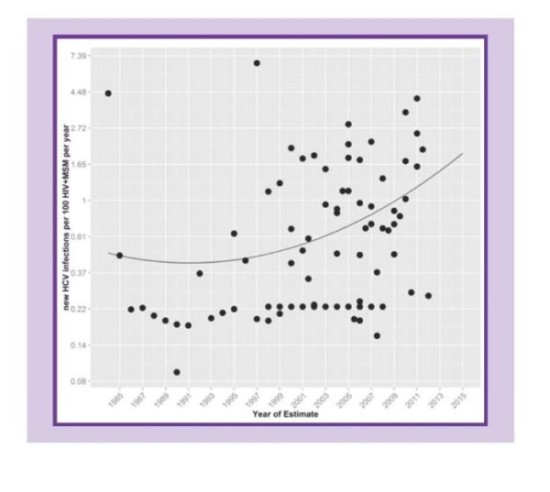Since 2000, there have been multiple reports of outbreaks of sexually-transmitted acute hepatitis C virus (HCV) infection in HIV-positive gay, bisexual, and other men who have sex with men (HIV+ MSM) in urban areas of North America, Europe, Australia, and Asia. HCV infection is more likely to become chronic in people who have HIV, and co-infection accelerates HCV-related liver damage and death, even in patients with undetectable HIV viral loads. Among heterosexuals in HCV-discordant partnerships, sexual transmission is extremely rare.
The purpose of this systematic review and meta-analysis was to synthesize research characterizing the incidence of HCV transmission in HIV+ MSM who do not inject drugs. HCV transmission related to injection drug use is already well-characterized, and so the focus of this study was on sexual transmission in this population.
- In 17 studies that followed 13,000 HIV+ MSM in Europe, North America, Australia and Asia to observe HCV transmission, there were 0.5 new infections per 100 HIV+ MSM per year
- Plotting the incidence rates over calendar time showed that the rate has more than tripled between 1991 and 2012 from 0.4 new infections per 100/year, to 1.3 per 100 HIV+ MSM/year. The figure shows the rates of HCV infection by individual years (as dots) and a fitted line shows the
trend toward increasing infection rates - Most of the new infections were attributable to high-risk sex behaviors such as receptive anal intercourse without a condom, rectal trauma with bleeding during sex, and sex while high on methamphetamines
- Some of the studies followed those with newly acquired HCV who had subsequently been treated for HCV and cured, and in that group HCV reinfection was not uncommon, at 11.4 reinfections per 100 HIV+ MSM/year

The HCV incidence rate was quite low compared to people who inject drugs (PWID), among whom the rate ranges between 10-40/100 per year. However, the fact that sexual HCV transmission in HIV+ MSM is increasing is a disturbing trend and will add to the burden of liver disease and death in this population. The high rate of reinfection (more than twice the rate among PWID who are successfully treated for HCV) suggests that there is a subgroup of HIV+ MSM who have recurring exposures to HCV via high risk sexual practices, often fueled by the use of stimulant drugs.
Current recommendations for management of HCV among HIV+ MSM center on detecting new infections through screening every 3-6 months and providing treatment for HCV infection. In the face of increasing infection rates and high reinfection rates, these steps alone may not be the most effective approach. Interventions that address individual sexual and drug use behavior are needed to reverse these troubling trends.
Hagan H, Jordan AE, Neurer J, Cleland CM (2015).
Incidence of sexually transmitted hepatitis C virus infection in HIV-positive men who have sex with men
AIDS, 29 (17), 2335-2345. doi: 10.1097/QAD.0000000000000834. PMCID: PMC4640945.
Or contact Holly Hagan: hh50@nyu.edu.
The HCV Synthesis Project is supported by a grant by the National Institutes of Drug Abuse (R01DA034637) and by the Center for Drug Use and HIV Research (P30DA011041).
